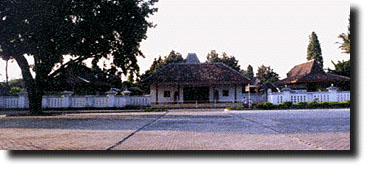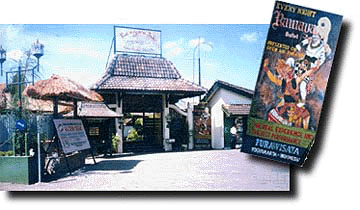THE NEW CITY
(Yogyakarta)
The main thoroughfare in Yogyakarta is Jl. Malioboro in the downtown. The road from Tugu train station in the north and runs straight down to the Karaton at the south end, it is the most attractive road of the city, which is always busy days and nights.

Street vendors on Malioboro sidewalk
Many important buildings and places are located along this road. The 'number one' Tourist City of Java has some places of interest worth to see, among other;
Museum Sasono Wiratama
Located at West Yogya, also known as museum Diponegoro, built at his former residence. Prince Diponegoro had lead a bloody war against the Dutch colonialists (1825-1830).

Museum Sasono Wiratama
Museum Sasmitaloka
Located at the memorial home of General Sudirman on Jl. Bintaran, 2 km east of main Post Office. General Sudirman, the commander of the Indonesian Arm Forces led the war against the Dutch occupations during the independence war. He died in 1949, shortly after liberating Yogya.
Open daily except Monday.
Museum Perjuangan
Located on Jl. Sugiyono, South Yogya. It contains objects of historical interest related to the struggle for independence.
Museum Ki Hajar Dewantoro
Located at his former residence at Jl. Muja Muju, east of Puro Pakualaman. He was a nobleman from Pakualaman family, a fighter for independence and a prominent educator founder of Taman Siswa school system.
Yogya has several museums dedicated to independence struggle, it is also called the city of revolution. Yogya has always been a symbol of resistance to colonial rule, it was the capital of Republic from 1946 - 1949. The Sultan of Yogya, the late Sri Sultan Hamengkubuwono IX, bravely joined the Republic against the aggressors and supported by Sri Paku Alam VIII.
The full support of Yogyakarta Royal Families has important role in the struggle for independence. As a result of this support, Yogya is granted as a Special Region answerable directly to Jakarta.
Museum Affandi
Located on Jl. Solo, 5 km from centre of the city on the West Bank of Gajah Wong River. He lived here until his death in 1990. Affandi, the best known painter internationally. The museum exhibits some of his masterpieces and works from other painters. His daughter, Kartika, is also a well-known painter.
The Biological Museum
Located on Jl. Sultan Agung 22, 1 km east of Post Office has a collection of Indonesian flora and fauna specimens. There are dioramas illustrate a variety of natural environments.
Pasar Ngasem
On west of Karaton, known as a local bird market, selling different kinds of colourful birds, bird feed and cute bamboo ornamental cages. In the same market, some potteries for daily use such as braziers, water-jars, moneyboxes are available. Sold also some ingridients of jamu (traditional herbal medicine) and handsome leather money belts and pouches.
Gembira Loka Zoo
It is relatively a small zoo located on the bank of river Gajah Wong, 3 km east of main Post Office. It has interesting collection of animals, local and foreign.
In the compound, there are recreational facilities such as a pond for boating and children's playground. During school holidays, gamelan and musical entertainment are performed.
Purawisata Amusement Park
Located on Jl. Brigjen. Katamso, east of Karaton. It has several facilities:
- Open stage to perform Ramayana Wayang Wong (human wayang), every evening. If it is raining played in the hall.
- Children Playground
- Musical Performance in the evening, usually Dangdut music (Malay-Indian-Arabian combined beat).
- Fun fair games and art market-selling souvenirs.
- Some foodstalls and a good restaurant serving local and Western cuisine.

Monument Yogya Kembali
Located on the north Yogya, on the way to Kaliurang. It is dedicated for the struggle of independence. During holidays, many school children and students visit it.

Monument Yogya Kembali
Gajah Mada University
Located in the north part of the town, 3 km from Tugu railway station. It is one of the state's premier universities. The campus is very large, consist of many buildings with different faculties. There is a special department for foreign post-graduate students. Yogya is also referred as the City of Students, many students come from 27 provinces in Indonesia for studying here.
Yogya has many higher institutions and vocational training schools (one of the eldest in the country is Academy of Leather Processing)
There are also other higher schools pertaining to arts, such as AMI - Academy of Music (for studying of modern music) located 1-km southward of South Square, ASTI - Institute of Arts (for studying handicrafts, paintings, Javanese dance and gamelan music), ASRI - Academy of Fine Arts (for studying sculpture making). The three have been merged to become: ISI - Indonesia, Institute of Arts, address: Jl. Parangtritis Km. 6.5, Phone 62-274-375 380
Mesjid Agung
Located westward of North Square, traditionally connected with Karaton. This Grand Mosque has a Javanese architecture.

Mesjid Syuhada
A modern Mosque equipped with library, located at Kotabaru, 1-km eastward of Tugu Railway station.
Church (Gereja) Kotabaru
A pleasant Catholic Church at Kotabaru, located 1 km east of Tugu Railway Station.

Church Kotabaru
Vihara
A Chinese Buddhist Temple, located on Jl. Gondomanan, o,5 km east of main Post Office.
Jagadnata Pura Hindu
A Buddhist Temple (pura), located on Jl. Sorowajan, northeast Yogya, about 4 km from Malioboro.
Jamu (Herbal Medicine) and Traditional Cosmetics
The Yogyakarta keeps the beliefs of the traditional jamu's benefits. It has the capability to cure various diseases and can keep health and fitness of human bodies. The traditional method of using jamu is by boiling the herbs and then drinks it (called jamu godog).
Nowadays are more practical, there are powder, pills, capsules and liquid, 'Ready to Drink'. There are also lotions and ointments for outside application.
Click here for 'List of Producer of Jamu and Traditional Cosmetic'!
Gurah
Just recently the trendiest jamu exposed is called Gurah. Originally it was an ancient way used by Pesinden (woman singer of Javanese gamelan orchestra) to beautify her voice when singing during a performance. Several days before her performance, One or two drops of liquid. From the root of Sirgunggu tree dropped on her nostrils. Soon a lot of mucus should come out from her nose and mouth. Thus the Pesinden was ready to sing with her best voice.
At present, Gurah is used also to cure some diseases with the same method of treatment or just by drink it (in capsules).
(Suryo S. Negoro)
to Entertainment ...

